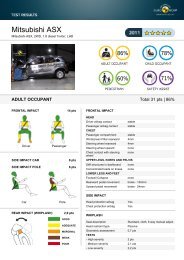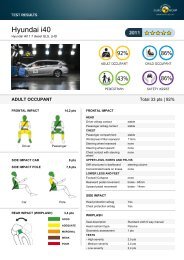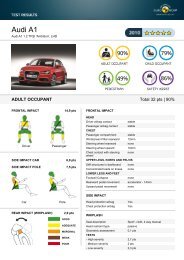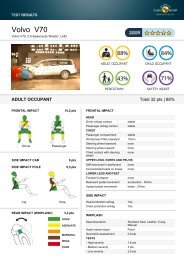Pedestrian Test Protocol - Euro NCAP
Pedestrian Test Protocol - Euro NCAP
Pedestrian Test Protocol - Euro NCAP
You also want an ePaper? Increase the reach of your titles
YUMPU automatically turns print PDFs into web optimized ePapers that Google loves.
4 <strong>Euro</strong> <strong>NCAP</strong><br />
detailed in<br />
Section 9.1<br />
to account for<br />
larger<br />
pedestrians<br />
Version 7.0<br />
March 2013<br />
Directly on localised sensor e.g. accelerometer, +/-50mm. For<br />
non-localised sensor systems test directly in line with the front<br />
longitudinal member to produce the highest acceleration levels on<br />
the impactor. This test may be performed using a representative<br />
surrogate with equivalent mass and stiffness to prevent damage to<br />
instrumentation.<br />
40km/h<br />
+/-2km/h<br />
HTD = Hardest to detect LT = Lower deployment Threshold<br />
2.2.3.2.3 At least test #3 shall be witnessed or performed by <strong>Euro</strong> <strong>NCAP</strong> to verify deployment<br />
of the system at the lower threshold. Alternatively, it may be performed by the<br />
manufacturer and witnessed at their facility.<br />
2.2.3.2.4 Where a test is performed below the lower threshold speed but within the velocity<br />
tolerance or outside the bumper test zone and the bonnet does not deploy, the test must<br />
be repeated at a speed no less than the lower threshold and not outside the bumper test<br />
zone.<br />
2.2.3.2.5 The outputs from all physical tests shall include, but is not limited to:<br />
• Good quality high speed film showing an overview of the test.<br />
• Documentation of the correct test location, e.g. using paint marks and post test<br />
photographs.<br />
• Documentation of test speed (vehicle or impactor as applicable), e.g. using<br />
known road markings or speed measurement systems etc.<br />
• Actuator trigger time (current clamp/ECU).<br />
• Evidence of bonnet deployment initiation, i.e. film showing the first movement<br />
of the bonnet top or frangible break wires/contacts/squibs.<br />
2.2.3.2.6 The first physical test, or tests, must be performed with the pedestrian protection<br />
system fully functional from the sensing systems to the bonnet actuators. At the same<br />
time, it is acceptable to include an additional means of highlighting bonnet<br />
deployment, such as flashes and/or squibs for that first test. Once valid firing time and<br />
bonnet deployment has been confirmed, the remaining tests may then be performed<br />
with the flashes/squibs connected in place of the bonnet actuators; thus negating the<br />
need for bonnet deployment. The entire system architecture should be present up to the<br />
bonnet actuators for all tests. Flashing hazard warning lights or other indications that<br />
are not connected to the actuator wiring system will not be accepted.<br />
2.3 Timing of Bonnet Deployment<br />
2.3.1 Time independent & fully deployed devices<br />
2.3.1.1 Where the manufacturer has demonstrated, by numerical simulations or alternative<br />
means (vehicle speed of 45km/h), that a system is fully deployed and remains in the<br />
intended position prior to the head impact time of the smallest appropriate stature<br />
pedestrian, as defined in Section 2.2.1, then all headform tests shall be performed with<br />
the bonnet in the fully deployed position. There will be no need to trigger any active<br />
elements during the sub system pedestrian tests.<br />
2.3.1.2 Where the bonnet is shown to be fully deployed before the head impact time (HIT) of<br />
all adult headform locations, then the dynamic adult headform tests may be replaced<br />
with static tests. All small adult/child headform tests will then be performed<br />
dynamically.<br />
2.3.1.3 The simulations shall be performed using the same CAE model/code and the same<br />
pedestrian stance detailed in Section 2.2.1 positioning the pedestrian on the vehicle<br />
centreline.<br />
2.3.1.4 Further details on performing static tests are provided in Section 8.5.<br />
2.3.2 Time dependent & partially deployed devices<br />
2.3.2.1 For systems that do not remain in a permanently deployed position then dynamic<br />
6
















